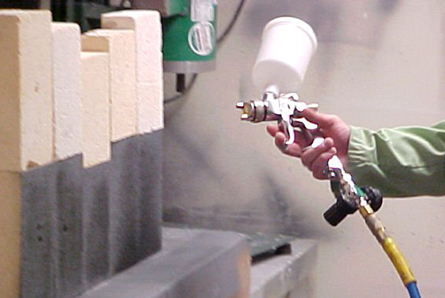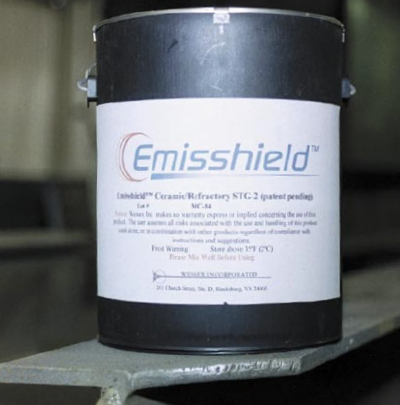A Coating That Cools and Cuts Costs
Originating Technology/ NASA Contribution
To enable low-cost space access for advanced exploration vehicles, researchers from NASA’s Ames Research Center invented and patented a protective coating for ceramic materials (PCCM) in 1994. The technology, originally intended to coat the heat shields of the X-33 and X-34 next-generation vehicles for optimum protection during atmospheric reentry, greatly reduces surface temperature of a thermal control structure while it reradiates absorbed energy to a cooler surface or body, thus preventing degradation of the underlying ceramic material.
Partnership
NASA Ames developed PCCM for use on ceramic fibers, but ongoing tests at the Center concluded that the coating could be effective on many other materials. As a result, Ames opted to align with a commercial partner to bring the protective coating technology to industry for thermal and fire protection. Wessex Incorporated, of Blacksburg, Virginia, obtained a partially exclusive license for PCCM in 1996, followed by an expanded exclusive license in 2001 for all fields other than space applications. Wessex initially applied the protective coating to building materials, specifically wood and steel for firewall applications. Through further testing and experimentation, however, the company would eventually come to learn the true potential of PCCM, leading to longer-lasting materials, greater energy conservation and fuel efficiency, increased productivity, and significantly reduced operating costs for numerous U.S. businesses.
Product Outcome
Known commercially as Emisshield,™ Wessex’s PCCM product mirrors NASA’s original PCCM coating in that it provides increased “hemispherical” emissivity—the ability to absorb energy and reradiate it to a cooler surface, body, or atmosphere. The Ames scientists who invented PCCM determined the emissivity of the coating to be between 0.8 and 0.9, making it a “grey body.” This means that the ratio of energy absorbed is not exactly the same as the amount of energy reradiated (a substrate that absorbs all energy regardless of the direction or wavelength of the energy and is a perfect radiator of the same energy is considered a “black body,” but to date, no such substrate exists, so a grey body is known to have the highest emissivity). Many substrates can have high emissivity values at ambient or lower temperatures, but as the temperature climbs, the emissivity of these non-grey body materials can decrease rapidly. Since PCCM was developed to withstand the extreme conditions of reentry, which involve going from -250 °F to almost 3,000 °F in a matter of seconds, the emissivity agents in the coating and in its commercial descendant maintain their grey body capabilities at temperatures exceeding 3,000 °F. In other words, PCCM and Emisshield will continue to absorb and reradiate at the same ratio, over a great range of temperatures.
Like PCCM, Emisshield can be reused and repeatedly cycled between severe extremes of subzero temperatures and temperatures over 3,000 °F, without ever damaging the protective coating or the underlying material. With each use, the coating’s molecular structure is rearranged to create a stronger bond between the coating and the underlying material, and an even greater level of thermal protection. In essence, the protective coating actually improves over time.
Wessex has embraced a high rate of success with Emisshield beyond its initial accomplishments in fireproofing building materials. In automotives, Modern Materials Incorporated, of Rochester, Indiana, is using Emisshield’s AR-1 blend to coat racecars and automotive parts. The coating was recently applied to the driver’s compartment of a racecar to lower floor pan temperatures that regularly range from 740 °F to 760 °F. By absorbing most of the heat and redirecting it away from the floor of the driver’s compartment, Emisshield AR-1 cooled down the floor pan temperature to 370 °F—almost 50 percent cooler than an untreated floor pan.
Separately, Emisshield was applied to the header pipes and collectors of a 1,400-horsepower, 800-cubic inch V-8 pro-stock dragster. Before the coating, the engine was tested by a dynometer for background performance. After the initial performance readings, the engine’s header pipes and collectors were removed, grit-blasted, and coated with Emisshield on the outside only. The coating was allowed to dry for 1 hour before testing resumed on the engine in the same manner as before the coating was applied. Results from the follow-up test showed that Emisshield was able to increase horsepower by 15, decrease the pounds of fuel used by 26 pounds per hour to yield the higher horsepower, and reduce the outer surface temperature of the header pipes and collectors by 550 °F. These results will not only impact drag racers but other types of race engines, along with the engines that are put into everyday street cars.
While the demand for Emisshield in various fields remains steady, Wessex is concentrating on three key areas: petrochemical production, metal heat treating, and general refractory applications such as boilers and heat exchangers. The company has discovered that the coating, when applied to refractories or the tubes in boilers, can help increase the efficiency of a process by requiring less fuel to yield the same amount of product.
To demonstrate this boost in efficiency, Wessex teamed with Virginia Carolina Refractory, of Denver, North Carolina, to apply Emisshield to the afterburner of a batch kiln that cures catalytic converter elements. The purpose of the afterburner is to heat the exhaust gasses during the kiln cycle to completely burn the organic binders that are discharged from the catalytic converter elements. In the kiln’s total cycle of 48 hours, 25 percent of the total fuel usage is consumed by the 80-foot-long, 6-foot-tall afterburner to ramp up and maintain a temperature of 1,400 °F. Virginia Carolina Refractory wanted to see a decrease in fuel use and a shorter ramp-up time to reach 1,400 °F.
It took 15 gallons of the Emisshield ST-2 product to coat the entire afterburner, using a spray gun. In 3 months, the natural gas burners that are controlled by thermocouples hanging in the afterburner were able to be kept open at a rate between 25 percent and 29 percent, after previously being kept open at a rate setting of 35 percent. By reradiating energy back into the afterburner with Emisshield, the fuel needed to keep the afterburner at 1,400 °F could be reduced, ultimately shortening the ramp-up time. This translated into energy savings of approximately 23 percent in the afterburner chamber for an entire year, or a savings of $360,000 per year for owners of this batch kiln.
Emisshield also proved to be the coating of choice in tempering a heat treating furnace. In testing the impact of this application, a company from Tulsa, Oklahoma, coated the interior of a 1,200-pound loaded furnace with Emisshield and left an identical loaded furnace uncoated. Temperature readings taken from both furnaces revealed that the Emisshield-coated furnace took 1 hour less than the uncoated furnace to reach the prime operating temperature of 1,350 °F. This 30-percent decrease in total time-to-temperature represents an increase in production for operators. The coated furnace also cooled down faster than the uncoated model, reaching 600 °F in only 13 minutes, compared to 20 minutes.
To improve sales and distribution of Emisshield products, Wessex has united with Pittsburgh, Pennsylvania-based Harbison-Walker Refractories LTD, and Houston, Texas-based Thorpe Corporation to promote the coating in North America for a variety of industrial applications.
In June 2003, Emisshield was honored by NASA as a “Turning Goals into Reality” commercial technology award recipient. This award was presented in recognition of accomplishments deemed the most outstanding contributions toward each of NASA’s Enterprise goals and objectives.
Wessex and Ames continue to work together on a regular basis and have recently discussed the potential use of Emisshield for some of NASA’s thermal applications. Ames has received samples of the Wessex coatings for evaluation of their compatibility with research projects currently underway.
Emisshield™ is a trademark of Wessex Incorporated.

Samples are sprayed with Emisshield ST-1 in Wessex Incorporated’s laboratory.

Emisshield™ absorbs energy and reradiates it over a great range of temperatures, providing maximum protection for surfaces and underlying materials.













